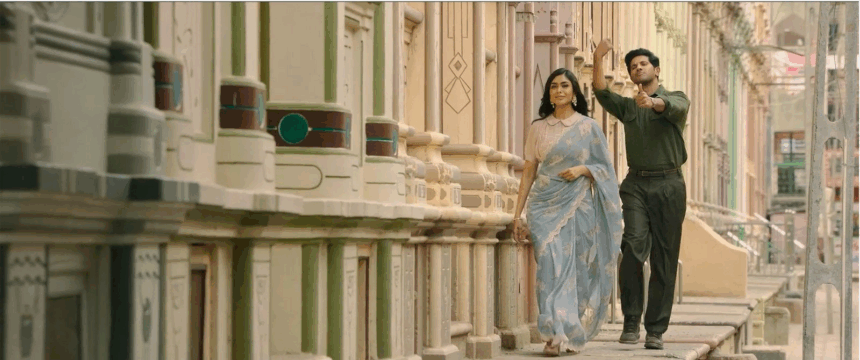In Sita Ramam, architecture is more than a decorative backdrop. It operates as a narrative presence that shapes mood, frames relationships, and anchors the film within its historical setting. From the snow-covered expanses of Kashmir to the ornate interiors of palatial homes, the spaces chosen and constructed serve the dual purpose of aesthetic delight and storytelling clarity.
As the director guides the viewer through an era defined by handwritten letters and long train journeys, the production design and location choices ensure that every wall, corridor, and arch feels lived in and contextually accurate.
Period Architecture as Emotional Anchor
Picture Courtesy- Cinema Express
The film’s production design captures the texture of the 1960s and 1980s with remarkable discipline. Historic palaces, vintage railway compartments, and colonial-era government buildings contribute to the authenticity of the narrative. Architectural historian Spiro Kostof once said, “Architecture is a mirror of its time.” In Sita Ramam, this mirror reflects the post-independence optimism of public spaces and the personal intimacy of domestic interiors.
For instance, the Hyderabad residence of Sita Mahalakshmi is a carefully dressed set that conveys warmth and refinement. The high ceilings, carved teak furniture, and patterned floor tiles evoke a sense of generational continuity. Such spaces ground the romance in a tangible world and remind the viewer that love stories are often shaped by the rooms in which they are told.
Kashmir’s Landscape as Architectural Canvas
Picture Courtesy- MX player
Kashmir appears not just as scenery but as an expansive architectural space shaped by nature. The valley’s terraced fields, stone bridges, and traditional wooden homes form a spatial rhythm that mirrors the evolving relationship between Sita and Ram.
One of the most memorable visual compositions places the characters in front of a snow-dusted house, the geometry of its sloping roof echoing the simplicity of their conversation. The cold clarity of the landscape provides a deliberate visual contrast to the warmer tones of interiors in other parts of the film.
Frames within Frames
Picture Courtesy- Vy Jayanthi Network
The cinematography often uses architectural framing to enhance emotional intimacy. Doorways, arches, and mirrors become devices to guide the audience’s gaze and to create visual metaphors for distance, longing, and secrecy.
A particularly striking scene shows Sita and Ram through a series of mirrors in a grand hall. The reflection creates a layered composition, each panel revealing a different facet of their interaction. This visual approach is reminiscent of techniques used in period films where mirrors and windows symbolise parallel realities or concealed truths.
Crafting Authentic Interiors
Picture Courtesy- Youtube/ Vy Jayanthi Network
Art director Vaishnavi Reddy and production designer Sunil Babu achieved a remarkable balance between realism and cinematic appeal. They sourced antiques, textiles, and architectural elements that were either period originals or carefully reproduced.
Three notable elements of interior design in Sita Ramam:
- Floor Patterns
Intricate geometric tiles and inlaid marble floors anchor the characters in spaces with cultural depth.
- Ceiling Treatments
Exposed beams and coffered ceilings add dimension and visual weight to rooms.
- Furniture Placement
Sofas, writing desks, and daybeds are positioned to shape blocking and actor movement without feeling staged.
Such choices demonstrate how design can guide direction, allowing conversations to occur within visually balanced frames.
Transitional Spaces and Emotional Geography
Picture Courtesy- YouTube/ Jio Hotstar
The film uses corridors, courtyards, and staircases as transitional spaces where key moments occur. These are not merely passageways but narrative bridges. A courtyard scene in Hyderabad captures the lingering pause between dialogue, the surrounding colonnade adding rhythm to the emotional beat.
Similarly, the railway platform sequences are crafted with precision. Here, architecture meets motion; the long canopy, iron trusses, and tiled station floor heighten the anticipation of arrivals and departures.
The Train as Moving Architecture
Picture Courtesy- YouTube/ Sony Music South
Trains in Sita Ramam are not just vehicles of travel but extensions of the built environment. The wood-panelled compartments, vintage luggage racks, and sliding doors act as small yet expressive architectural settings. The limited space forces proximity between characters, amplifying emotional stakes.
Architect Le Corbusier famously described a house as “a machine for living in.” In this film, the train carriage becomes a machine for storytelling.
Light as Architectural Companion
Picture Courtesy- YouTube/ Sony Music South
Light interacts with architecture throughout the film, shaping mood and meaning. Indoor scenes in Hyderabad glow with the golden tones of oil lamps and filtered sunlight through jali screens, creating an atmosphere of softness. In Kashmir, the pale winter light reflects off snow into interiors, adding an almost ethereal quality.
Such use of light aligns with principles found in heritage architecture, where openings and reflective surfaces are strategically placed to guide both illumination and emotional experience.
When Architecture Becomes Character
Picture Courtesy- YouTube/ Sony Music South
By the film’s conclusion, certain locations have taken on the qualities of characters themselves. The palace halls, the Kashmir home, the railway station, and the letter-filled study are not interchangeable backdrops. They are part of the emotional memory of the story, shaping how viewers recall the narrative.
Frank Lloyd Wright once said, “The mother art is architecture. Without an architecture of our own we have no soul of our own civilisation.” In Sita Ramam, the architecture carries not only the soul of the period but also the soul of the love story.

Ar. Pranjali Gandhare
Architect | Architectural Journalist | Historian






